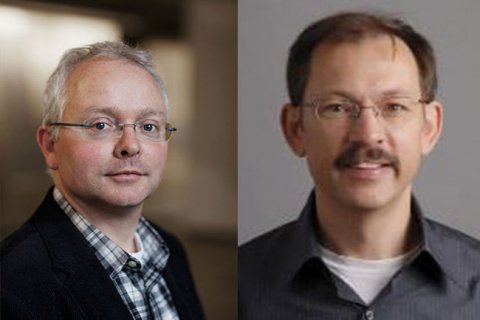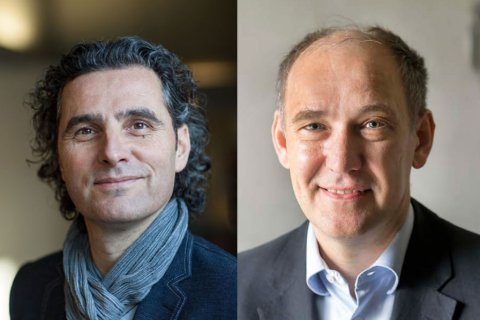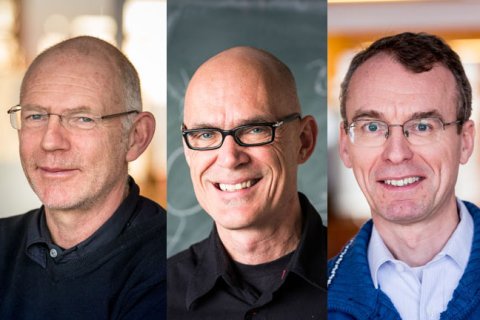Six million euros granted to Utrecht chemistry researchers
Three out of four NWO TOP-PUNT grants awarded to Utrecht University
No less than three of the accepted TOP-PUNT grants of NWO Chemical Sciences have been awarded to teams of chemistry researchers at Utrecht University. They will each receive two million euros to start new, challenging and innovative research lines. In total, NWO awarded four out of thirteen received research proposals. The three Utrecht research teams that will receive the grant are Marc Baldus and Alexandre Bonvin (Bijvoet), Albert Heck and Geert-Jan Boons (Bijvoet and UIPS) and Willem Kegel, Daniël Vanmaekelbergh, and Andries Meijerink (Debye).

Prof.dr. Geert-Jan Boons and prof.dr. Albert Heck (chemistry/pharmacy), Bijvoet Center for Biomolecular Research and Utrecht Institute for Pharmaceutical Sciences
Combining chemical synthesis and analysis to reveal the biology regulated by protein glycosylation
Almost all cell surface and secreted proteins are modified by covalently-linked carbohydrate moieties and the glycan structures on these so-called glycoproteins are essential mediators for biological processes such as protein folding, cell signaling, fertilization, embryogenesis, neuronal development, hormone activity and the proliferation of cells and their organization into specific tissues. In addition, overwhelming data supports the relevance of glycosylation in pathogen recognition, inflammation, innate immune responses, and the development of autoimmune diseases and cancer. Advances in understanding the biological roles played by glycans on proteins, along with the factors that influence or alter their functions, will be central to understanding biology and will provide important avenues for the development of therapeutics, diagnostics and nutraceuticals of the future. We propose to develop an integrated approach of sophisticated synthetic chemistry, mass spectrometry and biology to uncover structures and functions of cell surface glycoconjugates.

Prof.dr. Marc Baldus and prof.dr. Alexandre Bonvin (chemistry), Bijvoet Center for Biomolecular Research
Caught in the act: a combined magnetic resonance – modelling approach to capture cellular machines at work
Physiological processes can only rarely be attributed to individual molecules but rather involve complex interactions within molecular assemblies on different temporal and spatial scales. In the latter case, compartmentalization via membranes is a common principle in nature to control fundamental biological functions, including bioenergetics, communication, sensing, and organization. In these processes, membrane-embedded proteins (MPs) play a central role and great progress has been made in elucidating their three-dimensional atomic structures. To describe and understand these processes in situ and at the most detailed, i.e., atomic level, we propose an integrative approach that combines latest advancements in the fields of experimental cellular structural biology (in particular NMR) and computational structural biology to explicitly study membrane complexes and their workings at atomic scale.

Prof.dr. Daniel Vanmaekelbergh, prof.dr. Willem Kegel, and prof.dr. Andries Meijerink (chemistry), Debye Institute for Nanomaterials Science
Superficial Superstructures: Control of Colloidal Ordering at Interfaces
Two-dimensional semiconductors and metals with a superimposed geometry, i.e. a periodic array of holes on the nano- to micrometer scale, became renown very recently as a new and promising platform for materials with electronic and photonic properties controlled by geometry. The objective of the proposed research is to develop a widely usable bottom-up fabrication method for creating such twodimensional geometric semiconductors, metals or polymers. The method will be based on the use of colloidal particles with anisotropic bonding sites used in interface-templated self-assembly followed by oriented bonding, and – in some cases - atomic crystallization. This endeavor will require a detailed understanding of surface-mediated directional interactions between either nanocrystals or colloids.
More information
Nieske Vergunst, press officer faculteit Faculty of Science, Utrecht University, N.L.Vergunst@uu.nl

